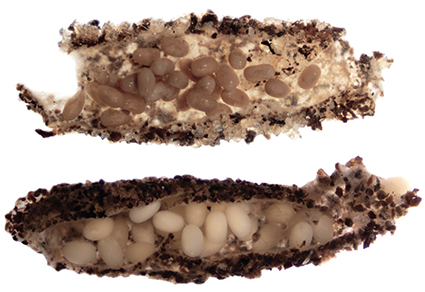Abstract
The egg chorion morphologies of Dahlica triquetrella (Hübner, 1813) and Dahlica lichenella (Linnaeus, 1761) are described. These two species well differ from each other by diameter of the micropyle, by number of micropyle pores, and by diameter of the micropyle rosette.
References
Arbogast, R.T., Brower, J.H. & Strong, R.G. (1989) External morphology of the eggs of Tinea pallescentella Stainton, Tinea occidentella Chambers, and Niditinea fuscella (L.) (Lepidoptera: Tineidae). International Journal of Insect Morphology and Embryology, 18 (5), 321–328. https://doi.org/10.1016/0020-7322(89)90013-5
Arbogast, R.T., Lecato, G.L. & Byrd, R. (1980) External morphology of some eggs of stored-product moths (Lepidoptera: Pyralidae, Gelechiidae, Tineidae). International Journal of Insect Morphology and Embryology, 9 (3), 165–177. https://doi.org/10.1016/0020-7322(80)90013-6
Arnscheid, W.R. & Weidlich, M. (2017) Psychidae. In: Karsholt, O., Mutanen, M. & Nuß, M. (Eds.), Microlepidoptera of Europe. Vol. 8. Brill, Leiden/Boston, pp. 1–423. https://doi.org/10.1163/9789004340220
Chauvin, G. & Barbier, R. (1972) Perméabilité et ultrastructures des oeufs de deux Lépidoptères Tineidae: Monopis rusticella et Trichophaga tapetzella. Journal of Insect Physiology, 18 (8), 1447–1462. [in French with English summary] https://doi.org/10.1016/0022-1910(72)90224-7
Davis, D. (1990) First record of a bagworm moth from Hawaii: description and introduction of Brachycyttarus griseus De Joannis (Lepidoptera: Psychidae). Proceedings of the Entomological Society of Washington, 92 (2), 259–270.
Davis, D., Quintero, D., Cambra, R. & Aiello, A. (2008) Biology of a new Panamanian bagworm moth (Lepidoptera: Psychidae) with predatory larvae, and eggs individually wrapped in setal cases. Annals of the Entomological Society of America, 101 (4), 689–702. https://doi.org/10.1093/aesa/101.4.689
Dolinskaya, I.V. (2016) Comparative morphology on the egg chorion characters of some Noctuidae (Lepidoptera). Zootaxa, 4085 (3), 374–392. https://doi.org/10.11646/zootaxa.4085.3.3
Dolinskaya, I.V. (2019) The use of egg characters for the classification of Notodontidae (Lepidoptera), with keys to the common Palaearctic genera and species. Zootaxa, 4604 (2), 201–241. https://doi.org/10.11646/zootaxa.4604.2.1
Lee, G.E., Hayden, J. & Kawahara, A.Y. (2014) External egg morphology of the Hawaiian dancing moth, Dryadaula terpsichorella (Lepidoptera: Tineidae). Journal of Natural History, 48 (15–16), 969–974. https://doi.org/10.1080/00222933.2013.839845
Kolesnichenko, K.A. & Sidorov, A.V. (2021) Fine structure of the egg chorion in Catocala (Lepidoptera, Erebidae). Entomological Review, 101 (5), 593–600. https://doi.org/10.1134/S0013873821050018
Regier, J.C., Mitter, C., Davis, D.R., Harrison, T.L., Sohn, J.-C., Cummings, M.P., Zwick, A. & Mitter, K.T. (2014) A molecular phylogeny and revised classification for the oldest ditrysian moth lineages (Lepidoptera: Tineoidea), with implications for ancestral feeding habits of the mega-diverse Ditrysia. Systematic Entomology, 40, 409–432. https://doi.org/10.1111/syen.12110
Salkeld, E.H. (1984) A catalog of the eggs of some Canadian Noctuidae (Lepidoptera). Memoirs of the Entomological Society of Canada, 127, 1–167. https://doi.org/10.4039/entm116127fv


